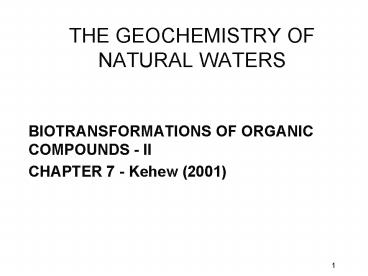THE GEOCHEMISTRY OF NATURAL WATERS - PowerPoint PPT Presentation
1 / 17
Title:
THE GEOCHEMISTRY OF NATURAL WATERS
Description:
... capacity - The amount of a xenobiotic compound that can be metabolized by aerobic ... Nitrate reduction is an important pathway for xenobiotic compounds ... – PowerPoint PPT presentation
Number of Views:180
Avg rating:3.0/5.0
Title: THE GEOCHEMISTRY OF NATURAL WATERS
1
THE GEOCHEMISTRY OF NATURAL WATERS
- BIOTRANSFORMATIONS OF ORGANIC COMPOUNDS - II
- CHAPTER 7 - Kehew (2001)
2
LEARNING OBJECTIVES
- Classify microorganisms according to their
characteristics and metabolic processes. - Understand the implications of various metabolic
processes for natural and accelerated
bioremediation of contaminated aquifers.
3
AEROBIC RESPIRATION
- The dominant form of metabolism in the presence
of dissolved oxygen because it yields the
greatest amount of energy. - Saturation limit of O2 in water is 13 mg L-1 so
aerobic respiration is limited by availability of
O2. - Assimilative capacity - The amount of a
xenobiotic compound that can be metabolized by
aerobic respiration.
4
ENERGY YIELDS FROM METABOLIC PROCESSES
5
CALCULATION OF ASSIMILATIVE CAPACITY
- Assume benzene is metabolized to CO2 without
producing additional microbial cells. - C6H6 7.5O2 ? 6CO2 3H2O
- According to this reaction 7.5 moles ? 32 g mol-1
240 g O2 are required to metabolize 1 mole ? 78
g mol-1 78 g of benzene. - This yields a mass ratio of 240/78 3.081.
- The assimilative capacity of an aquifer with 10
mg L-1 O2 is therefore (10 mg L-1)/(3.08) 3.25
mg L-1.
6
ANAEROBIC RESPIRATION WITH NITRATE REDUCTION
- Nitrate reduction can be performed by obligate
anaerobes or facultative anaerobes. - Denitrification (reduction of nitrate to
molecular oxygen) occurs via a series of steps
involving NO2- and N2O. Each step requires a
specific enzyme catalyst. - Nitrate reduction is an important pathway for
xenobiotic compounds - C6H6 6NO3- 6H ? 6CO2 3N2 6H2O
- To consume 1 mg L-1 benzene requires 1.1 mg L-1
nitrate-N (20-30 mg L-1 or more in many aquifers).
7
ANAEROBIC RESPIRATION WITH FERRIC IRON REDUCTION
- Ferric hydroxide coatings on mineral grains yield
a large assimilative capacity for anaerobic
metabolism. - Metabolism of toluene by iron-reducing bacteria
- C7H8 36Fe3 21H2O ? 36Fe2 7HCO3- 43H
- requires 36 moles of ferric iron per mole of
toluene! - Iron concentrations can be greatly increased.
Ferrous iron may be oxidized by chemolithotropic
bacteria under aerobic conditions this can cause
clogging problems in water systems.
8
Metabolic processes controlling fate of iron in
the subsurface.
9
ANAEROBIC RESPIRATION WITH SULFATE REDUCTION
- The presence of sulfate can significantly augment
the assimilative capacity of an aquifer for
metabolism of xenobiotics. - C6H6 3.75SO42- 7.5H
- ? 6CO2 3.75H2S 3H2O
- A 3.751 sulfate/benzene molar ratio translates
into a mass ratio of 4.61. - It takes 4.6 mg L-1 of sulfate to degrade 1 mg
L-1 of benzene.
10
METHANOGENESIS
- Archaebacteria employ methanogenesis as their
metabolic process. - Two main metabolic pathways
- CO2 reduction pathway
- 4H2 CO2 ? CH4 2H2O
- Essential H2 is produced by fermentative bacteria
(symbiotic relationship). - Acetate fermentation (acetate dissimilation)
pathway - CH3COOH ? CH4 CO2
- A minor but significant pathway
- C6H6 4.5H2O ? 3.75CH4 2.25CO2
11
CHEMOLITHOTROPIC PROCESSES
12
ACCLIMATION
- Once a microbial community becomes acclimated to
a specific xenobiotic, degradation proceeds
immediately upon addition of more of the
compound. Before that, there is a period where
little degradation occurs. - Reasons for the acclimation period
- Proliferation of small populations
- Presence of toxins
- Predation by protozoa
- Appearance of new genotypes
- Diauxie
- Enzyme induction
13
- Proliferation of small populations - When a
xenobiotic is first introduced, the proportion of
microbes that can degrade it may be small. It may
take several doublings of the population before a
change in xenobiotic concentration is noticeable. - Diauxie - Sequential utilization of two or more
carbon substrates. Bacterial community feeds on
substrate with the highest energy yield first.
The acclimation period could represent when the
bacteria are using the primary substrate. - Enzyme induction - The time required for this is
usually less than the acclimation period.
14
GROWTH-LINKED METABOLISM - I
- When substrate concentration is low, all of the
available substrate is used for cell maintenance
cell growth does not occur. - Only when the substrate concentration exceeds a
threshold does growth occur. Above the threshold,
exponential growth results in more rapid
substrate metabolism. - Monod equation
- where µ is the population growth rate, µmax is
the maximum growth rate and Ks is the substrate
concentration at 1/2 the maximum growth rate.
15
Kinetic models for declines in concen-tration of
compounds metabolized by micro-organisms.
S lt Km
Non-growth-linked conditions
S gt Km
S ? Km
S gt Ks
Growth-linked conditions
S ? Ks
S lt Ks
16
Growth rate of a population vs. substrate
concentration. The hyperbolic relationship is
described by the Monod equation.
17
GROWTH-LINKED METABOLISM - II
- Logarithmic decline - Occurs when the substrate
concentration is very high. Once the population
reaches a critical value, the substrate
concentration will decline rapidly. - Logistic decline - Occurs when the substrate
concentration is very low. Growth rate is
linearly proportional to substrate concentration,
and doubling of population takes longer as
substrate concentration decreases. - Monod, with growth - Intermediate case.































